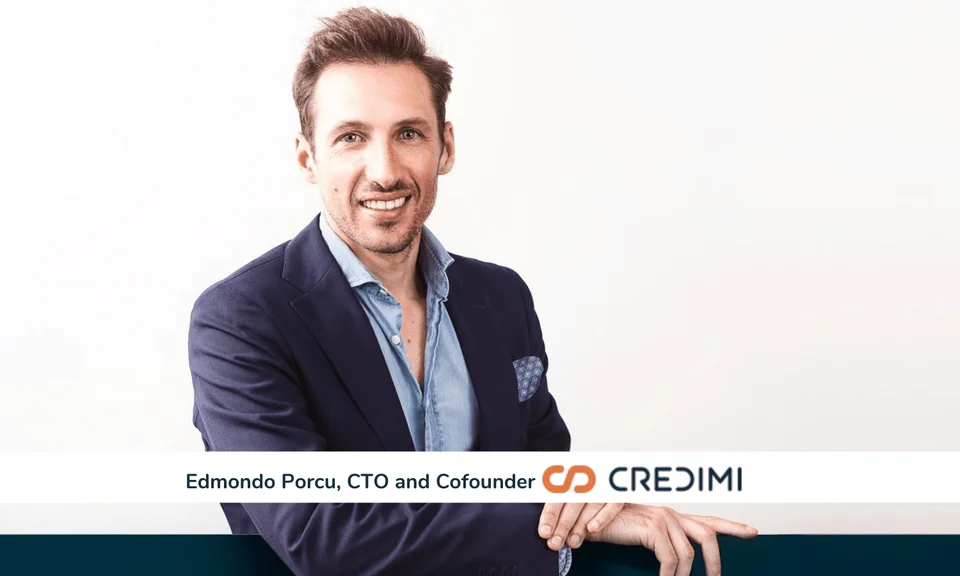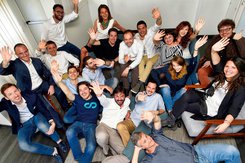- 10/09/2020

Dedicated to the global fintech community, it is our great pleasure to continue this series of interviews with fintech and insurtech leaders with Edmondo Porcu, CTO and Cofounder at Credimi.
Founded with the mission of simplifying credit access for Italian businesses, Credimi is a leader in digital financing for SMEs in continental Europe. Since 2017, Credimi has achieved record results with 51k requests processed from businesses and over €1 billion in funds granted, across all Italian industries, by offering medium-to-long-term digital financing services, factoring solutions, and supply chain finance to Italian SMEs.
What were some of your immediate pursuits after leaving Goldman Sachs as an executive director in 2016 and what inspired you to join Credimi? What has your experience been working in technology within a bank?
One of the unexpected surprises I had at Goldman Sachs was how much impact you could have there.
In late 2016 I felt it was time for me to take a riskier road: a start-up is an ideal place if you seek to trade higher impact for higher career risk. When other opportunities arose, Credimi was certainly the one whose mission, “Empower Business Growth”, I personally felt more aligned to.

The big lesson I learnt when working in the engineering department of GS was to consider myself as a risk manager. Every single employee is a risk manager, every single engineer is a risk manager: think about the classic build-vs-buy dilemma. How does the risk you accept when building a component in-house compare with the risk of vendor lock-in you accept when you adopt an external tool or platform? Risk can’t and should not be avoided, it should be actively managed. If everyone recognizes it’s their responsibility, you’ll achieve better outcomes as an organization.
In software development, what are the most interesting technological challenges that you and your team will have to work on in the coming months? Can you give us a glimpse into what you’re focused on?
The greatest challenge in technology as of today is giving business users more power. Technology departments used to work as gatekeepers, ensuring policies, rules, best practices were respected. Such an approach is valuable, but often cannot keep up with the pace of change in the world outside. As a result, many organizations have seen the rise of a shadow-IT, typically a complex set of Excel spreadsheets built to automate business processes and analysis. Such shadow-IT has been an incredible source of productivity gain and innovation, but these tools introduce risks: often they are maintained and understood by a single person, they do not go through versioning, they cannot be audited. Technology departments now need to work rather as shop-owners, providing business teams the right tools, the right coaching and the right guidance to allow non-technical users to thrive
What traits do you value most in colleagues?
I recently read “Conscious Business: How to Build Value Through Values ” by Fred Kofman (everyone at Credimi makes jokes about me because I love reading.) Kofman introduces the idea that people in the workplace can be categorized in players and victims. Players know they are not omnipotent and that there are plenty of things outside their control, they focus on what they can control and take full responsibility for their action. On the other side, victims delude themselves they are never wrong.
Needless to say, I love working with people who are players: failures are a part of the game and players see failure as an opportunity to learn. In Credimi autonomy and responsibility are core values and we value, attract and promote players.

One additional quality I highly value is a “system thinking ” mindset: nowadays world needs system thinkers. It makes sense to build software as independent blocks, to build a house “room by room ”. Many modern problems instead are too complex to be understood if you break them down into many parts because you lose the connection between the parts: before going down, we need go wide. When we look at the problems we are facing as a humankind, such as war, pandemic, climate change, clearly these can be addressed only by applying system thinking.
What have you been doing during this global pandemic to stay healthy and what role do your company play in supporting companies during this time?
Right, these are two questions and they deserve two separate answers. First, Credimi does a lot for its employees. We immediately recognized our employees are our most important assets and we treat them with an extra-large welfare package, continuous learning opportunities, incredible personal support and more. The combination of company support and daily exercise routine allowed me to go through the pandemic without “too many bad consequences ”.

During the pandemic, in line with our mission, we concentrated our efforts to sustain businesses. We have seen a peak in the credit demand, and we have worked hard to integrate all the legal and regulatory changes into our product offering. We placed extraordinary focus in ensuring the time from application to the wire transfer stayed under control, as receiving money quickly was more important than ever. In partnership with an Italian bank we also issued 100% guaranteed loans to around one thousand of their customers. Knowing we were playing a role in making it less hard for others was a key factor in our team motivation and I think overall, we got out of it stronger.
What are some things you learned while at Goldman Sachs that have helped you along the way?
I learned at Goldman Sachs the importance of influencing people around you. Marshall Goldsmith, a leading executive coach and former professor at UCLA, draws an important distinction between being smart and being effective. One very pernicious behavior among successful people is the need to prove how smart they are. It's the reason we feel the need to tell someone who shares information with us that "we already knew that " though it devalues them. Imagine I offer you a Brain Pill: if you swallow it you will become than 10% smarter than you are, but to everyone you know, and you will meet in the future, you will seem 20% less intelligent. In other words, you will become smarter, but the rest of the world will see you as dumber. Do you take the pill?
One additional learning at GS was that flat organizations scale well. This concept relates to the idea I was mentioning before: “everyone is a risk manager ”. Although GS was apparently a hierarchical organization, in reality you can speak to almost anyone in the firm in a very open way. Paul Walker, back in the time Partner and Co-Head of Technology department, had weekly office hours where each employee could schedule some time with him: within a few months from my start date, I used one slot to share with him some ideas. Since then, we had periodic checkpoints and I was introduced to other senior figures in the organization to share the ideas with them as well. One of those senior leaders was Joanne Hannaford, currently Partner and head of EMEA Technology, who introduced me to other leaders and was attentive to my ideas. Looking backward it was amazing how some senior leaders, so much more senior than me, were helping me to grow my influence and have a positive impact on the firm.
There was one additional learning which relates to scaling, and in particular to scaling decision-making. Goldman Sachs leadership perfectly understood that an organization needs to place trust and responsibility on its teams and to provide guiding principles and core value. The firm made great work on people and culture, in a consistent and repeated manner.

Think about software engineering: software engineers make hundreds of decisions per day. Should I make this more flexible at the cost of investing a little bit more time developing it? Should I automate this manual step? Should I create a specific test case for this scenario? It’s very hard to review these decisions in a later moment and assess whether they were appropriate or not. It’s difficult to say if one software engineer, given what she knew at the time, made the right choice or the wrong choice. And if she didn’t know enough, could she have known more? In modern organizations, you can succeed only if you work constantly to share your values and principles with each employee and you count on them to make the right choices.
In your opinion, what will be the 'frontier' technology stacks that will emerge and will be decisive for your projects?
As we live in the era of Big Data, companies struggle to extract value from their data assets. The key challenge is that data is spread out across different hundreds or thousands operational databases, which are designed for single row insert and update. Running analyses which join data from different systems is impossible, and single system analysis, when possible, are highly inefficient and complex to build on a single database. They also run the risk to overload those databases compromising availability of other systems. Technology stacks that allow to consolidate data from different sources in a single repository, allowing business users to perform discovery and self-service analytics, while guarding the security and protecting confidential information, are becoming critical.

One additional challenge is that as the pace of change increases, we need to increase the speed at which we can deliver technological solutions to end users. Low/No coding platforms are getting an incredible traction. Unqork, a New York based company that builds a no-code platform for the enterprises, raised 131M$ in a round B from Google Capital, GS and Blackrock, among others. Salesforce has always made clear that its strategy was to make most of the use cases/scenarios possible with pure configuration (check out their beautiful article on their engineering blog: “Metadata: Software The Way You Want It”). Automation Anywhere, an Enterprise Robot Process Automation platform, raised a total of 840M$ including 250M$ in a round led by Goldman Sachs and 290M$ led by Salesforce Ventures. A great challenge most organizations will be facing, including Credimi, will be to find the right way to combine these low-code/no-code solutions with software engineering to maximize business value. There are creative solutions to these problems, such as embedding software engineering skills in business teams, or having centralized teams responsible to build “core components ” who can be employed in workflows designed by business users. It’s a very fascinating problem.
Thank you Edmondo for answering our questions and we wish you all the best.



![What [the heck] is InsurTech? image](https://media.fintastico.com/images/network-782707_1280.2e16d0ba.fill-72x72.png)